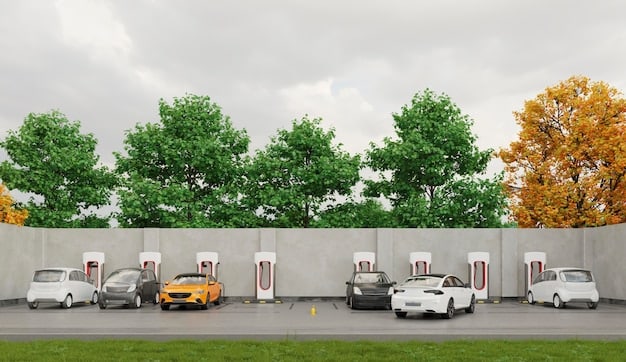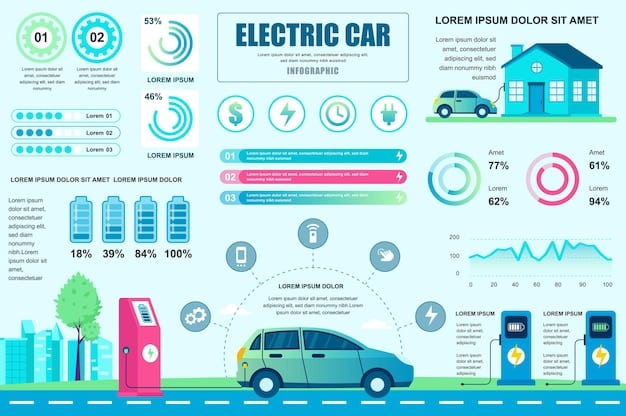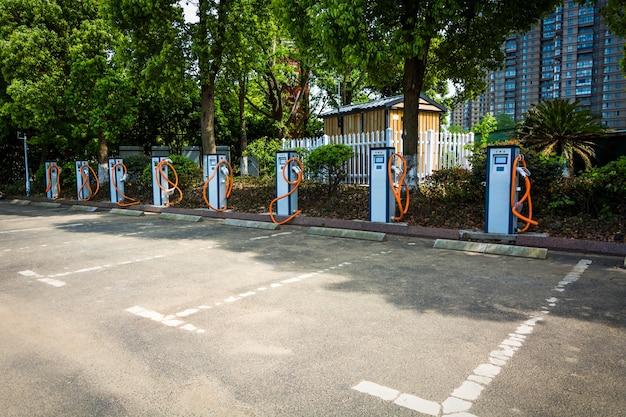The Growth of Electric Vehicle Charging Infrastructure in the US: Challenges and Opportunities

The growth of electric vehicle charging infrastructure in the US is crucial for widespread EV adoption, yet faces significant challenges like uneven deployment and high costs, alongside opportunities for innovation and public-private partnerships.
The automotive industry is undergoing a massive shift towards electric vehicles (EVs). As more drivers make the switch, the growth of electric vehicle charging infrastructure in the US: Challenges and Opportunities become increasingly apparent.
But what are the real hurdles and potential benefits of expanding this critical infrastructure? This article explores the challenges and opportunities that lie ahead for the growth of electric vehicle charging infrastructure in the US.
Understanding the Current State of EV Charging Infrastructure in the US
Currently, the US lags behind other developed nations in terms of EV charging infrastructure per capita. Understanding the growth of electric vehicle charging infrastructure in the US: Challenges and Opportunities requires assessment of the current landscape.
Availability and Distribution of Charging Stations
The availability of charging stations remains uneven across the country. Urban areas tend to have a higher concentration of chargers, while rural areas often lack sufficient infrastructure.
Types of Charging Stations
There are three main types of EV charging stations: Level 1, Level 2, and DC Fast Charging (DCFC). Each type offers different charging speeds and is suited to various use cases.
- Level 1 Charging: Uses a standard 120V household outlet, providing the slowest charging speed (approximately 4-5 miles of range per hour).
- Level 2 Charging: Employs a 240V outlet, significantly increasing charging speed (around 20-30 miles of range per hour).
- DC Fast Charging: The fastest option, using high-voltage direct current to charge EVs rapidly (up to 80% charge in 30-60 minutes).
The challenges in the growth of electric vehicle charging infrastructure in the US: Challenges and Opportunities lie in scaling up DCFC availability and ensuring compatibility across different EV models.

Key Challenges in Expanding EV Charging Infrastructure
Expanding EV charging infrastructure is not without its challenges. Several key obstacles need to be addressed to facilitate widespread EV adoption.
High Installation Costs
The initial cost of installing charging stations, particularly DCFC units, can be substantial. This includes equipment costs, construction, and grid upgrades.
Grid Capacity and Stability
The existing electrical grid may not be capable of handling the increased demand from widespread EV charging. Upgrading grid infrastructure is essential to ensure reliability and stability.
Standardization and Interoperability
Lack of standardization in charging connectors and protocols can create compatibility issues. Ensuring interoperability between different EV models and charging networks is crucial for a seamless user experience.
Regulatory and Permitting Hurdles
Navigating the regulatory landscape and obtaining necessary permits can be a complex and time-consuming process. Streamlining these processes is essential to accelerate the deployment of charging infrastructure.
Overcoming these challenges is essential for sustainable the growth of electric vehicle charging infrastructure in the US: Challenges and Opportunities.
The Role of Government Incentives and Policies
Government incentives and policies play a vital role in stimulating the growth of EV charging infrastructure. Both federal and state initiatives are crucial.
Federal Initiatives
The federal government has implemented various programs to support EV adoption and charging infrastructure development. These include tax credits, grants, and infrastructure funding.
State and Local Policies
Many states offer additional incentives, such as rebates, tax credits, and grants, to encourage the installation of charging stations. Local governments are also implementing policies to support EV adoption.
Effective policies and incentives can significantly accelerate the growth of electric vehicle charging infrastructure in the US: Challenges and Opportunities, making it more accessible and affordable.

Private Sector Investment and Innovation
Private sector investment is crucial for driving innovation and accelerating the deployment of EV charging infrastructure. Numerous companies are actively involved in this space.
Charging Network Operators
Companies like Tesla, ChargePoint, and EVgo are expanding their charging networks across the country. They are investing in new charging technologies and partnerships to improve accessibility.
Automakers
Automakers are also investing in charging infrastructure, either directly or through partnerships with charging network operators. This helps ensure their customers have access to convenient charging options.
Technology Providers
Technology companies are developing innovative solutions for EV charging, such as smart charging systems, energy storage, and grid management technologies.
Public-Private Partnerships
Collaboration between public and private entities is essential for the growth of EV charging infrastructure. These partnerships can leverage the strengths of both sectors to achieve common goals.
This collaboration is essential for the overall growth of electric vehicle charging infrastructure in the US: Challenges and Opportunities.
Opportunities for Future Growth and Innovation
The future of EV charging infrastructure presents numerous opportunities for growth and innovation. Advancements in technology and business models are paving the way for a more sustainable and accessible charging ecosystem.
Smart Charging Technologies
Smart charging systems can optimize energy usage and reduce strain on the grid. These systems use data analytics and algorithms to schedule charging during off-peak hours and balance energy demand.
Wireless Charging
Wireless charging technologies offer a convenient and user-friendly alternative to traditional charging cables. These systems use inductive power transfer to charge EVs without physical connections.
Battery Swapping
Battery swapping is a technology that involves replacing a depleted battery with a fully charged one. This could provide an alternative to traditional electric vehicle charging and support the growth of electric vehicle charging infrastructure in the US: Challenges and Opportunities.
Renewable Energy Integration
Integrating renewable energy sources, such as solar and wind, into charging infrastructure can reduce the carbon footprint of EVs. This can be achieved through on-site renewable energy generation or by purchasing renewable energy credits.
Energy Storage Solutions
Energy storage systems, such as batteries, can store excess energy from the grid or renewable sources and release it during peak demand. This can help stabilize the grid and reduce the cost of EV charging.
Enhancing User Experience and Accessibility
Improving the user experience is critical for encouraging EV adoption. This involves making charging stations more accessible, reliable, and user-friendly.
Location and Convenience
Charging stations should be located in convenient and accessible locations, such as shopping centers, workplaces, and highway rest stops. This makes it easier for EV drivers to charge their vehicles while going about their daily routines.
Reliability and Maintenance
Charging stations should be well-maintained and reliable. Regular maintenance and upgrades are essential to ensure they are functioning properly and providing a consistent charging experience.
Payment Options and Pricing
Offering a variety of payment options and transparent pricing can improve the user experience. This includes credit card payments, mobile apps, and subscription services.
Information and Navigation
Providing clear and accurate information about charging station locations, availability, and pricing can help EV drivers plan their routes and charging stops effectively. Mobile apps and online platforms can be used to provide this information.
Ultimately, focusing on these factors will fuel the growth of electric vehicle charging infrastructure in the US: Challenges and Opportunities.
| Key Aspect | Brief Description |
|---|---|
| ⚡ Charging Types | Level 1, Level 2, and DC Fast Charging offer varied speeds. |
| 💰 Installation Costs | High costs hinder rapid expansion plans nationwide. |
| 🤝 Public-Private | Crucial collaborations help build infrastructure faster. |
| 🔋 Battery Tech | Innovations enhance charging convenience and efficiency. |
Frequently Asked Questions
The primary challenges include high installation costs, grid capacity limitations, lack of standardization, and regulatory hurdles that slow down deployment efforts.
The government supports EV infrastructure through tax credits, grants, and funding programs aimed at encouraging investment and expansion of charging networks.
The private sector invests in charging networks, develops new technologies, and forms partnerships to enhance charging accessibility and convenience for EV drivers.
Smart charging technologies optimize energy usage by scheduling charging during off-peak hours, which reduces strain on the grid and lowers energy costs for EV owners.
User experience can be enhanced by locating stations in convenient areas, ensuring reliability, offering various payment options, and providing clear information about pricing and navigation.
Conclusion
The future of transportation hinges on the growth of electric vehicle charging infrastructure in the US: Challenges and Opportunities. By addressing current challenges and embracing innovation, we can pave the way for a sustainable and accessible EV ecosystem.
Investment from governments, private companies, and collaborative partnerships will be required. A commitment to expanding and improving EV infrastructure is critical to enabling this technology.





